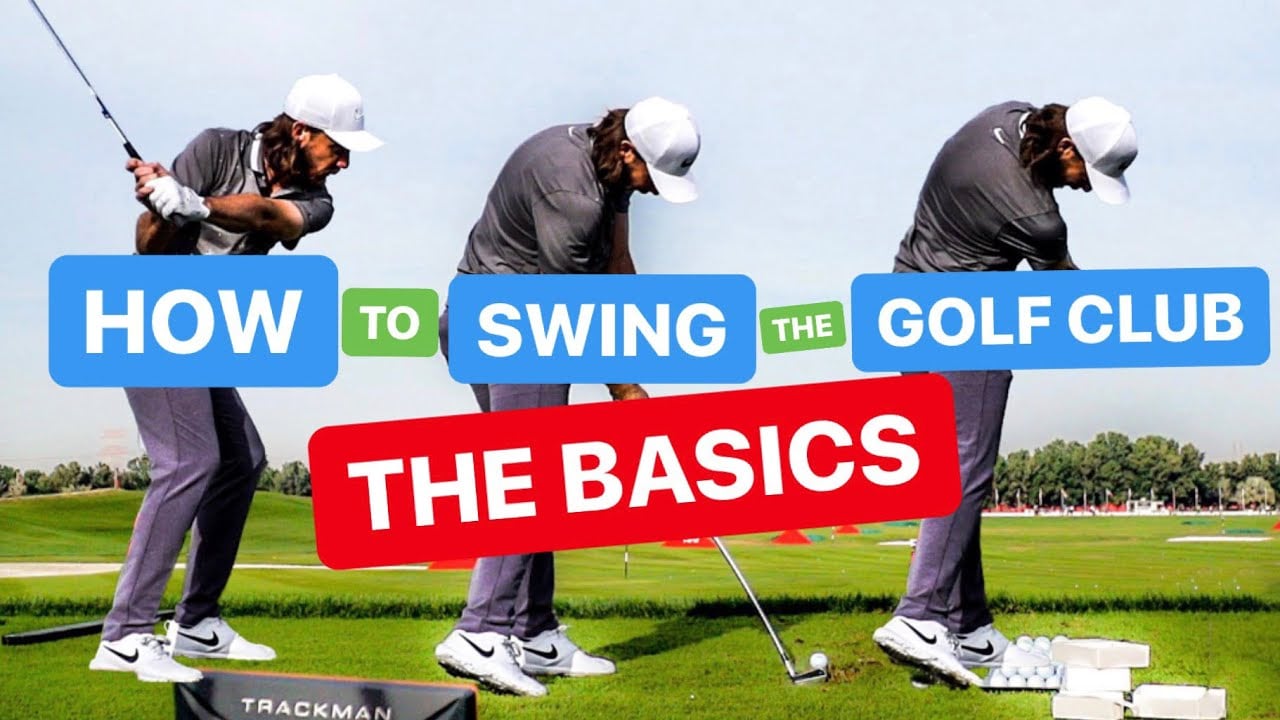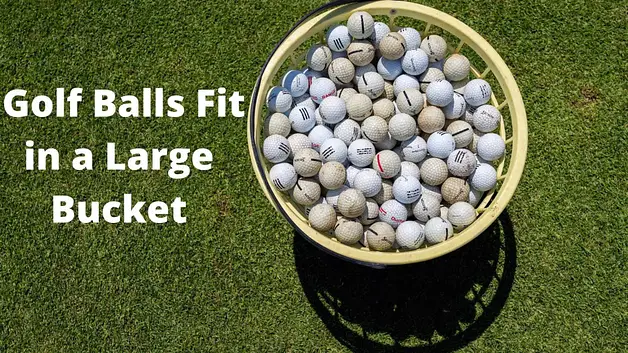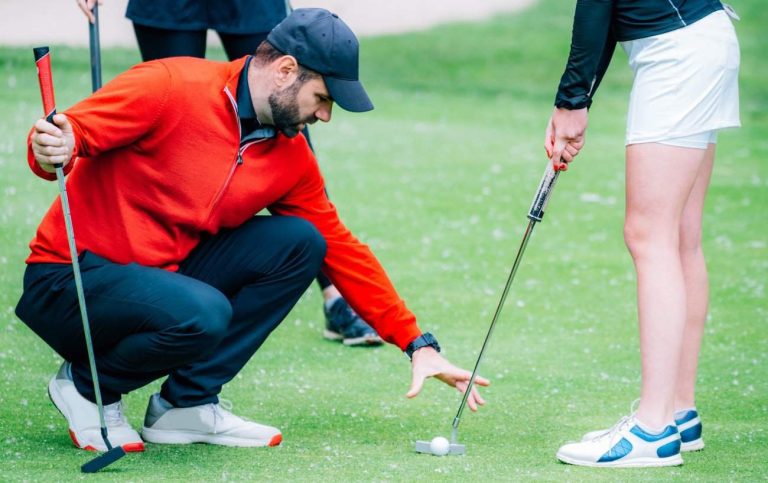Perfecting Your Swing: A Step-by-Step Guide on How to swing a golf club
Key Takeaway:
- Mastering the fundamentals of the golf swing is essential for success. This includes proper setup and grip, understanding pre-swing mechanics, and executing a powerful backswing.
- The downswing and follow-through are critical components of a good golf swing. Transitioning smoothly from the backswing, executing a powerful downswing, and maintaining balance throughout are key elements to focus on.
- Incorporating advanced techniques can further improve your golf swing. Consider utilizing a single plane swing for consistency and contact, maximizing power through hip and shoulder rotation, and increasing flexibility through stretches.
- Addressing common swing issues is important for improvement. This includes correcting slice, hook, and inconsistent golf ball striking, maintaining balance, and seeking professional guidance and practicing smartly.
Mastering the Fundamentals of the Golf Swing
Mastering the fundamentals of the golf swing is key to improving your game. In this informative section, we will explore essential aspects such as proper setup and grip, understanding pre-swing mechanics, and executing a powerful backswing. These sub-sections will provide valuable insights and techniques to enhance your swing, helping you achieve greater control and distance on the golf course.

Proper Setup and Golf Grip
For a successful golf swing, setup and grip are essential! Get familiar with the right hand positioning and overlapping grip. Plus, grip pressure and clubface alignment are crucial for success. A good posture and stance also play a major role in setting up correctly.
Follow this 4-step guide to understand and put into practice proper setup and grip:
- Hand positioning and overlapping grip: Place your top hand (left hand for right-handed golfers) above your bottom hand (right hand for right-handed golfers). Interlock the fingers of your top and bottom hand (interlocking grip).
- Grip pressure and clubface alignment: Hold the club firmly but relax your grip. The clubface should be square to your target line.
- Posture and stance: Stand with your feet shoulder-width apart and slightly bent knees. Bend from your hips and keep your back straight. Keep your chin up and eyes on the golf ball.
- Pre-swing mechanics: Have your hands and arms in the right position. Your arms should be extended but not stiff. Align your body parallel to the target line and the clubface correctly.
Remember, while setup and grip are important, other aspects contribute to technique improvement. Setup and grip can improve performance, but concentrating on maximizing hip and shoulder rotation can increase power and club head speed. Also, stretching exercises improve flexibility and make for a smoother swing.
Correct hand positioning and overlapping grip
For a great golf swing, the hand positioning and an overlapping grip are key. It helps keep control over the club and ensure proper clubface alignment. Also, grip pressure is really important for accuracy and consistency. Here’s a 6-step guide for the optimal hand positioning and overlapping grip:
- Put your hands on the club handle. Left hand (for right-handed golfers) should be slightly lower than the right.
- Wrap your fingers around the handle to create a tight grip.
- Place the right hand’s little finger between the left hand’s index and middle finger.
- Make a V-shape with the thumb and index finger of each hand, pointing towards your right shoulder.
- Keep your grip consistent, not too tight nor too loose.
- Check that the clubface is parallel to your leading forearm.
These steps will give you stability and control for a better swing. But there are more components to a good golf swing: posture, stance, pre-swing mechanics, backswing, downswing, hip and shoulder rotation. To improve, get help from a golf instructor and practice smartly.
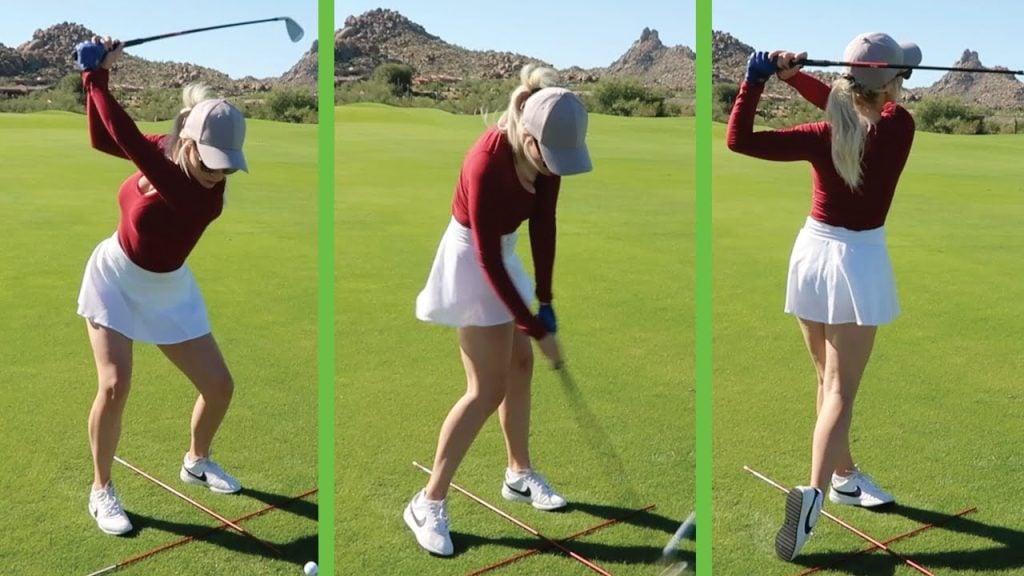
Don’t forget to have fun and keep positive! With a grip like a vice and a clubface like a laser beam, you’ll be the envy of your opponents.
Importance of grip pressure and clubface alignment
Grip pressure and clubface alignment are key for mastering golf. Knowing their importance is a must for accurate and consistent shots.
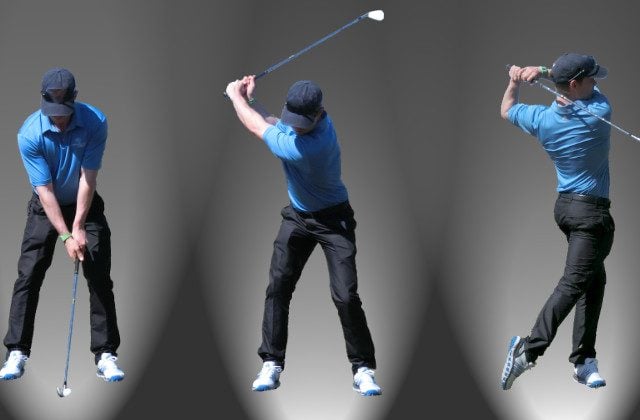
Good grip pressure lets the golfer control the club throughout their swing. This way, they can avoid exerting too much force and swing smoother, resulting in higher distance and accuracy.
Clubface alignment is also very important. Ensuring it’s at the right angle at address helps shots go in the desired direction. Not doing so leads to hooks or slices and higher scores.
To optimize grip pressure and clubface alignment, golfers should focus on having a neutral grip with a square clubface at impact. They can achieve this by positioning their hands correctly and overlapping their fingers. Additionally, maintaining consistent grip pressure helps control the clubface and overall shot performance.
By understanding and emphasizing grip pressure and alignment, golfers can improve their consistency, accuracy, and performance. Training drills and practice techniques that target these fundamentals will help develop a solid base for their swings.
Golf is like trying to fit a square peg into a round hole, except the hole is a swing and the peg is the body. This shows the importance of grip pressure and clubface alignment for optimal results.
Achieving the ideal posture and stance
Golfers need the ideal posture and stance for a successful swing. It helps them stay balanced, generate power, and increase accuracy. Follow these four steps to get it right:
- Feet shoulder-width apart: Place feet wider than your shoulders. This gives balance and stability.
- Bend from the hips: Keep your back straight and bend forward from the hips. Let your arms hang naturally.
- Slight knee flex: Keep a slight flex in your knees. This reduces impact and aids body weight transfer.
- Tilt from the waist: Tilt forward from the waist for an athletic position. Engage your core muscles and promote rotation.
Know how posture and stance affect power and accuracy. Get the pre-swing mechanics right to unlock the true power of your swing.
Understanding the Pre-swing Mechanics
Golfers must understand pre-swing mechanics for optimal control. Focus on grip, pressure and alignment of the clubface. Posture and stance should be ideal for stability. Hand and arm positioning must be firm yet relaxed. Avoid rushed swings and split practice time for technical and skill development. Professional guidance and video lessons can help.
An anecdote of a pro golfer who struggled due to improper pre-swing mechanics and improved through guidance emphasizes the importance of mastering these components.
Key elements in the pre-swing phase
Golf pre-swing phase is vital for a successful swing. During this stage, golfers focus on 3 key elements: hand & arm positioning, body alignment & club face alignment. This will provide them with a consistent swing path & proper clubface alignment.
Good hand & arm positioning ensures wrists aren’t too cocked. To get body alignment, golfers must align their body with the target line. Finally, club face alignment means it should be square to the target line.
By mastering these elements, golfers get a strong technical base to develop more advanced techniques & strategies. This will improve their overall game!
Importance of correct hand and arm positioning
Hand and arm positioning is key for a proper golf swing. The hands and arms directly affect clubface alignment, grip pressure, and swing mechanics. By positioning the hands and arms correctly, golfers can control the club and hit the ball accurately.
To get the correct hand position, it’s important to place them correctly on the grip and overlap them. This creates a secure hold on the club, unites the hands during the swing, and keeps the wrist neutral for clubface alignment.
Correct hand and arm positioning also impacts posture and stance. By aligning the body with the target line, golfers can improve accuracy and generate power.
In conclusion, correct hand and arm positioning is essential for mastering the golf swing. It impacts grip pressure, clubface alignment, posture, and accuracy. By focusing on this part of technique, golfers can build a strong foundation for further improvements in their swing.
Aligning the body and club face for accuracy
Get ready for ultimate accuracy! Achieving the ideal posture and stance is essential for proper alignment. Feet should be shoulder-width apart, knees slightly flexed, and spine neutral. Grip the club with an overlapping grip for stability and control.
Keep the club face square to the target line during the backswing. Then, during the transition from backswing to downswing, align the body and club face for accurate contact with the ball. Variations may occur due to individual preferences or physical abilities, so seeking guidance from a golf instructor can be beneficial.
Don’t forget the power of a powerful backswing for improved results on the golf course. Align your body and club face for the perfect golf swing!
Executing a Powerful Backswing
A powerful backswing is key for a successful golf swing. Use the larger muscles, such as the shoulders and hips, to generate power and stay in control of the clubface. Rotate these muscles in sync for more power and a smoother swing.
Maintain clubface alignment with the target line for better accuracy and control.
At the top of the backswing, get an optimal clubhead position. Wrist hinge and point the clubshaft towards or slightly behind the target line.
Practice these steps consistently to execute powerful backswings, resulting in improved performance. Don’t try to hit a 300-yard drive with noodle arms – use the bigger muscles for a smooth backswing!
Utilizing the big muscles for a smooth backswing
Golfers can enhance their performance on the course by utilizing the big muscles for a smooth backswing.
- To do so, start with proper posture and grip.
- Engage the lower body during initiation.
- Rotate with the core in a fluid and controlled motion.
- Avoid relying solely on arm strength.
Doing this increases power generation and accuracy, while also helping to prevent injuries. Practicing this technique will result in improved swing mechanics and enhanced performance.
Maintaining a square club face throughout the backswing
Optimizing your grip: Hand placement and overlapping grip are key to keeping your clubface square during your backswing. Position your hands correctly and use an overlapping grip to make it easier to stay aligned.
Grip pressure: It’s important to find the right balance of grip pressure to keep your clubface square. Too much tension can cause an open or closed clubface, resulting in inaccurate shots.
Posture and stance: Good posture with a slight bend from hips and knees also helps maintain a square clubface.
These fundamentals will help you maintain a square clubface throughout your backswing, leading to better accuracy. Pay attention to correct hand and arm positioning, and align your body and clubface at address.
For even better results, seek professional guidance or take video lessons from experienced instructors. Split your practice time between technique and skill development.
Enjoy the game while improving your swing. Put in the effort and you’ll reach the optimal clubhead position at the top of your backswing.
Mastering the Downswing and Follow-through
Transition smoothly from your backswing to the downswing and execute a powerful follow-through in mastering the art of golf. Learn how to master the downswing and follow-through to optimize your swing power and accuracy.
Discover key techniques and strategies to seamlessly transition from the backswing, unlocking the potential for a fluid and impactful downswing. With a focus on executing a smooth and powerful downswing, you’ll uncover the secrets to achieving optimal distance and control in your golf game.
Transitioning from backswing to downswing
Transitioning from backswing to downswing is a crucial part of the golf swing. It’s all about shifting weight, initiating the club’s forward motion, and keeping the clubface square to the target. Here’s a 4-step guide to make it happen:
- Before starting the swing, ensure steady balance with parallel body alignment and a good grip on the club.
- While transitioning, shift weight from your back foot to the front one. This will generate power and make the swing more fluid.
- Keep the clubface square throughout. Don’t flip or twist your wrists as it leads to inconsistent ball striking.
- If having trouble, ask your instructor for help. Experts can provide advice and feedback on any adjustments required.
Practice and repetition are key. The more you practice this transition, the better your golf swing will be.
Importance of weight transfer and lower body rotation
Weight transfer and lower body rotation are essential to a great golf swing. Moving weight from the back foot to the front left foot during the downswing creates more power and control. This shift maintains balance throughout the swing. Moreover, lower body rotation increases the speed of the clubhead.
To do this, focus on footwork and hip movement. When the club reaches the top of the backswing, shift the weight onto the front foot while rotating the hips towards the target. This creates forward momentum. Also, keep the clubface square for consistent contact with the ball.
Maximizing hip and shoulder rotation generates more power. When golfers rotate their hips and shoulders fully through impact, they create a whipping motion for greater distance. Try engaging core muscles, sequencing movements, and increasing flexibility.
In conclusion, weight transfer and lower body rotation are important for power, accuracy, and performance. Focus on footwork, hip movement, rotation, and flexibility to improve your game.
Maintaining a square club face during the transition
To maintain a square club face, follow these four steps:
- Grip pressure: Not too tight or too loose. Improves control and stability.
- Lower body rotation: Focus on rotating towards the target. Promotes a consistent impact position.
- Wrist hinge: Keep them hinged during transition and release at impact.
- Practice tempo and timing: Smooth tempo and timing. Prevents club face twisting or opening.
Maintaining a square club face is important. But, setup, grip, and alignment also play a role. Improve performance by addressing all aspects.
Square club face promotes power transfer, distance, and better control of shot shaping.
Golf Digest research found maintaining a square club face throughout transition is key to consistent and accurate ball striking.
Executing a Smooth and Powerful Downswing
A smooth and powerful downswing is a must in golf to hit the ball with accuracy and distance. You need to transition seamlessly from the backswing, properly transfer weight and stay balanced. Here are 3 steps to nail it:
- Transitioning from backswing to downswing: Move weight from back foot to front foot, initiated by lower body rotation. Hips lead the downswing, keep clubface square.
- Building speed and releasing energy: Gradually increase clubhead speed with bigger muscles like core and legs. Release energy from body into club for max power.
- Optimal impact and following through: Strive for solid contact between clubface and ball. Maintain form by shifting weight towards target as you strike. Follow through with swing, let the club complete its path.
These techniques will help ensure a smooth and powerful downswing that will give you accurate shots and increased distance. It takes practice, consistency and attention to detail for optimal performance on the course. Professional golfers spend hours refining their technique and working on their downswings to achieve maximum efficiency in their swings (Reference Data).
So, build speed progressively and release energy. Who needs a fancy car when you can unleash power on the golf course?
Building speed progressively and releasing energy
To master speed buildup and energy release in your golf swing, there are four steps to follow:
- Begin with a smooth, controlled takeaway, increasing clubhead speed as you transition from the backswing to the downswing.
- Generate power with proper sequencing – transferring weight, rotating the lower body and hips towards the target.
- Keep the clubface square to the target line for accuracy and consistency.
- Release energy through wrist extension and upper body rotation.
These steps lead to longer drives and improved consistency. Every golfer has unique nuances, so working with an instructor or taking video lessons can help personalize the approach. Practicing and implementing these techniques will also help develop muscle memory and consistency.
The principles of building speed and releasing energy have been around for decades. Now there are numerous tools and resources to enhance this understanding.
Proper weight transfer and maintaining balance
Weight transfer and balance are key components of a golfer’s swing. To maximize power and control, the golfer must transfer weight correctly. Balance is also essential for accurate ball striking. Here is a 3-step guide to achieving proper weight transfer and balance:
- During the backswing, shift your weight onto your back foot. This will create torque and let you coil your body. Keep your upper body centered and have a slight flex in your knees.
- Initiate the downswing by shifting your weight onto your front foot. This will help you generate clubhead speed and deliver a powerful strike at impact.
- Throughout the swing, evenly distribute your weight between both feet. Don’t lean too far forward or backward. A stable base will give better control and let you connect with the ball.
It is important to note that weight transfer and balance are connected to other fundamentals of the golf swing. These include grip, posture, and alignment. When all elements are executed well, it leads to improved accuracy and distance.
To improve weight transfer and balance, practice drills that target these areas. For instance, hit balls with a narrowed stance or do exercises that focus on core stability and lower body strength. Refining these aspects of your game will help you hit more consistent shots.
Achieving the optimal impact position and following through
- Big muscly swings: Engage your hips and shoulders during the downswing to generate power.
- Keep the clubface square.
- Weight transfer from back foot to front for impact.
- Balance and coordination needed for effective swing.
- Finish with full follow-through for a complete motion.
To get better at golf, get help from a pro or take video lessons.
Split practice time between technique and skills to refine your game.
Troubleshooting Common Swing Issues
Correcting slice, hook, and inconsistent ball striking as well as maintaining balance and avoiding swing complications are key focuses in the “Troubleshooting Common Swing Issues” section. Learn how seeking professional guidance and practicing smartly can help you improve your golf swing.
Correcting Slice, Hook, and Inconsistent Ball Striking
Mastering the technique for a proper golf swing can correct issues such as slice, hook, and ball striking inconsistencies. These troubles can impede a golfer’s performance and accuracy. By understanding and applying the right changes, players can better their swing and get more consistent results.
Grip pressure and clubface alignment can assist in fixing slicing and hooking. During pre-swing, proper hand and left arm placement is vital for optimal ball striking. Aligning body and clubface correctly leads to better accuracy in each shot. Keeping the clubface square throughout the backswing is imperative for a powerful swing.
From backswing to downswing, make sure to transition smoothly. This includes weight transfer and lower body rotation, helping to avoid inconsistencies in ball striking. Also, progressively build speed in the downswing and release energy at the right time for more powerful shots.
Sustaining balance throughout the swing is important to avoid complications and ensure consistent results. Learning from golf instructors and using video lessons can give great insights on improvements. Devoting practice time to both swing technique and skill enhancement is beneficial. But, above all, have fun with the game and focus on the positive to enhance overall performance.
Pro Tip: Utilize visualization techniques to reinforce correct swing mechanics mentally, and thus improve consistency on the course.
Tips for improving the consistency of ball striking
Getting consistent ball striking is a major part of mastering the golf swing. It needs a mix of proper technique, body control, and focus to get accurate and strong shots. With these tips, golfers can make their ball striking dependable and upgrade their performance on the course.
- Use correct grip: The proper golf grip pressure is very important for reliable ball striking. An overlapping grip offers control and steadiness with the club, while keeping an even clubface aids in hitting straight shots.
- Settle into ideal posture and stance: Having the perfect posture and stance before the swing matters for consistent ball striking. By properly positioning the body and having a square clubface at address, golfers can increase their chances of making solid contact with the ball.
- Focus on pre-swing mechanics: Paying attention to the basics in the pre-swing phase, such as arm and hand positioning, helps create a strong foundation for a consistent swing. When these elements are correct, golfers can set themselves up for success during impact.
- Execute a powerful backswing: Using big muscles of the body during the backswing helps a smooth and powerful motion. Keeping a square clubface throughout this phase and having an optimal clubhead position at the top of the backswing, golfers can generate more power and accuracy.
- Transition smoothly into the downswing: Correct weight transfer and lower body rotation are very important for transitioning from the backswing to the downswing. This ensures energy is passed effectively from one phase to the next, resulting in increased speed through impact.
In the end, getting consistent ball striking needs care to detail in many aspects of the swing. Golfers must focus on grip, posture, pre-swing mechanics, backswing execution, transition into downswing, plus keeping balance throughout. With diligent practice and guidance from professionals when needed, golfers can enhance their ball striking consistency and take their game to new heights.
Maintaining Balance and Avoiding Swing Complications
- Stable Stance: Set feet shoulder-width apart. Align them parallel to target line. Distribute weight evenly, with slightly more on balls of feet. This provides a solid foundation for swing.
- Proper Posture: Bend from hips. Keep spine straight and lower back with natural curve. Avoid slouching or hunching over ball. This allows for optimal rotation & weight transfer.
- Balance Weight Transfer: Focus on transferring weight from backswing to downswing. Start by shifting onto back foot. Then, shift onto front foot gradually. Keeping this balanced allows for control & consistency.
- Consistent Tempo: Maintain even tempo throughout swing. Avoid sudden movements or rushing certain phases. This promotes balance & synchronization, avoiding swing complications.
Mental focus & relaxation are essential. Tension or anxiety disrupts balance & hinders performance. Develop good balance habits & practice – to enhance overall game.
Pro Tip: Yoga or specific balancing exercises off the course improve core stability & balance. Result? Controlled & effective golf swing!
Importance of balance and avoiding rushed swings
Balance and a steady tempo are vital for consistent and accurate shots. Maintaining balance means more control and stability, which leads to better shots. Fast swings usually mean bad technique and misalignment, resulting in poorer accuracy and distance.
Focus on weight transfer and body positioning to remain balanced and avoid rushed swings. Proper weight transfer between the backswing and downswing keeps you stable, helping you transfer energy from your body to the clubhead. This energy creates a powerful swing and reduces chances of losing control or balance.
Additionally, keep your lower body still during the swing. This way, the upper body can generate power without sacrificing balance or making unnecessary movements that disrupt the timing.
Also, be deliberate in each phase of the swing. Taking time to set up correctly with the right grip, posture, stance, and alignment creates more consistent shots. Rushing any part of the swing causes rushed transitions, which often lead to bad shots or inconsistent ball striking.
In conclusion, balance and a steady tempo are necessary for successful golf swings. Focus on weight transfer, stability in the lower body, and a consistent pace throughout each part of the swing to improve accuracy and distance.
Pro Tip: Visualize a smooth rhythm as you swing to stay balanced and avoid rushing. Find a tempo comfortable enough to remain in control and balanced throughout your swing.
Remember: Balance is key in weight transfer, so step on the scale before swinging!
Techniques for maintaining balance throughout the swing
To get consistent, accurate results on the golf course, balance throughout the swing is key. The right techniques and body positioning can help maintain stability and control during a swing, which leads to improved performance. Here’s what to consider when wanting to stay balanced during a swing:
- Ideal posture and stance: Have a great foundation with a neutral spine angle, hips bent and slightly flexed knees. This posture provides better weight distribution and stability.
- Grip pressure: A firm but relaxed grip. Too much tension results in loss of control. Finding the perfect balance of pressure gives more stability.
- Weight transfer: Switching weight from back foot to front foot is essential for generating power and staying balanced. Do this smoothly and gradually.
- Body alignment: Make sure hips, shoulders and feet are aligned parallel to the target line. This stops swaying or sliding, thus promoting steadiness.
- Core muscles: Engaging core muscles keeps the body stable during a golf swing.
- Balance drills: Do drills like standing on one leg or using wobble boards to build control over body movements.
These tips will help golfers stay balanced while swinging. This not only improves performance, but lowers the risk of injury and allows for more consistent results. For better skills, practice these techniques and get guidance from a pro. Start today for a more stable and controlled swing.
Some Facts About How To Swing a Golf Club:
- ✅ Shortening the backswing and pausing at the top can help prevent swinging too hard in golf. (Source: Team Research)
- ✅ Lightening grip pressure allows for better wrist control and rotation, leading to a smoother and more rhythmic swing. (Source: Team Research)
- ✅ Trying a single plane swing can promote consistency and cleaner contact with the ball. (Source: Team Research)
- ✅ Increasing flexibility through stretches can help optimize rotation and achieve a more fluid swing. (Source: Team Research)
- ✅ The setup, grip, and posture are key elements in the pre-swing, ensuring proper alignment and balance. (Source: Golf Digest)
FAQs about How To Swing A Golf Club
What is a Three Step Routine in a golf swing?
A Three Step Routine in a golf swing refers to the sequence of steps that players follow to execute their swing. It consists of the pre-swing setup, the takeaway, and the actual swing movement. The routine helps golfers maintain consistent form and maximize their power and accuracy.
How should I position my feet in the proper stance for a golf swing?
To achieve a proper stance in a golf swing, position your feet shoulder-width apart. This provides a stable base and optimal balance throughout the swing. Keeping the feet at shoulder-width helps with weight transfer and allows for efficient rotation during the swing.
What is the benefit of skill practice in improving my golf swing?
Skill practice in golf involves focusing on game-like situations and shots rather than just technical aspects. Regular skill practice helps golfers develop their decision-making, shot selection, and execution. It improves their ability to transfer their swing mechanics to on-course performance.
How does pushing back with the hips contribute to a better golf swing?
Pushing back with the hips helps establish the proper golf posture and maintain balance throughout the swing. The movement helps create a stable base, allowing for more efficient weight transfer and rotation during the swing. It also helps prevent excessive lateral movement, promoting a more controlled and consistent swing.
Why is it important to align the body parallel left (for right-handed players) of the target in golf?
Aligning the body parallel left (for right-handed players) of the target in golf ensures that the swing path and clubface are aligned correctly at impact. This alignment promotes accuracy and consistency in hitting the ball towards the intended target. It helps golfers aim properly and reduces the chances of misalignment causing errant shots.
How can properly positioning the head down during a golf swing lead to better contact with the ball?
Properly positioning the head down during a golf swing helps maintain good posture and eye focus on the ball. By keeping the head steady and down, golfers are more likely to make clean contact with the ball. This leads to improved ball control, better accuracy, and more consistent shots.
